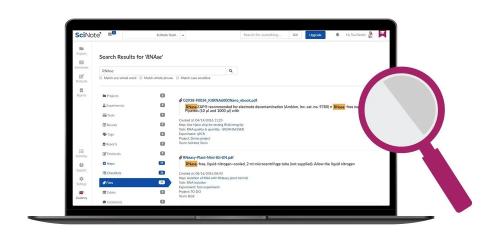Benefits and Differences of using ELNs and LIMS


In the dynamic landscape of laboratory management, two prominent tools have gained significant traction - Electronic Lab Notebooks (ELNs) and Laboratory Information Management Systems (LIMS). Both serve as integral components of modern laboratories, albeit with distinct functionalities. This article aims to dissect the benefits and differences between ELNs and LIMS, shedding light on their unique features and applications.
Understanding ELNs
Electronic Lab Notebooks, commonly known as ELNs, are digital versions of traditional paper lab notebooks. They serve as comprehensive platforms for researchers and scientists to record, manage, and share experimental data in electronic format.
Features of ELNs
Data Recording and Storage: ELNs enable researchers to record experimental procedures, results, and observations digitally. This data is stored in a central, accessible repository.
Collaboration: Collaboration is streamlined as multiple users can access and contribute to the same electronic notebook. This fosters teamwork and knowledge sharing.
Search and Retrieval: ELNs often come equipped with powerful search functionalities, making it easy to retrieve specific information. This aids in efficient data mining and analysis.
Data Security: ELNs provide mechanisms for data encryption and access controls, ensuring the security and integrity of sensitive research data.
Benefits of ELNs
Enhanced Collaboration: One of the primary advantages of ELNs is the facilitation of collaboration among researchers. Multiple users can simultaneously work on the same experiment or project, leading to increased efficiency and faster outcomes. Real-time collaboration transcends geographical boundaries, enabling global research teams to work seamlessly.
Data Accessibility and Searchability: ELNs provide a central repository for all experimental data, making it easily accessible to authorized users. The robust search functionalities embedded in ELNs allow researchers to swiftly locate specific information. This accessibility and searchability not only save time but also contribute to more informed decision-making.
Version Control and Audit Trails: Maintaining the integrity of research data is paramount. ELNs offer version control features, allowing researchers to track changes made to entries. Additionally, audit trails provide a chronological record of all actions taken within the electronic notebook, ensuring transparency and accountability.
Integration with Instruments and Applications: ELNs can seamlessly integrate with laboratory instruments and other applications, streamlining data capture and analysis. This integration reduces manual data entry errors and accelerates the pace of research by automating repetitive tasks.
Cost-Efficiency: While the initial implementation cost of ELNs can be a consideration, the long-term benefits often outweigh the investment. ELNs contribute to cost-efficiency by reducing the need for physical storage space, minimizing paper and consumable expenses, and enhancing overall research productivity.
Deciphering LIMS
Laboratory Information Management Systems, or LIMS, are software solutions designed to streamline and automate the management of laboratory processes and data. Unlike focuses on the overall administration and organization of laboratory operations.
Features of LIMS
Sample Management: LIMS excels in sample tracking, and managing sample workflows from collection to analysis. This includes sample identification, storage, and retrieval.
Workflow Automation: LIMS automates laboratory workflows, reducing manual errors and improving efficiency. This includes task scheduling, instrument integration, and result reporting.
Data Integration: LIMS integrates with various instruments and systems, ensuring seamless data flow across the laboratory. This facilitates a more interconnected and efficient research environment.
Regulatory Compliance: LIMS often come with features to support compliance with regulatory standards and requirements. This is crucial for laboratories operating in regulated industries.
Benefits of LIMS
Efficient Sample Management: LIMS excels in managing the entire sample lifecycle, from collection to disposal. This includes sample identification, tracking, storage, and retrieval. The automation of sample management processes significantly reduces the chances of errors and enhances the overall efficiency of laboratory operations.
Workflow Automation and Standardization: LIMS automates complex laboratory workflows, ensuring consistency and standardization in processes. Automation leads to reduced turnaround times, increased throughput, and a decrease in manual errors. This is particularly beneficial in high-throughput environments where large volumes of samples are processed.
Data Integration for Holistic Insights: The ability of LIMS to integrate with various instruments and systems creates a cohesive research environment. This integration ensures that data flows seamlessly across the laboratory, providing researchers with holistic insights. Real-time data access facilitates quicker decision-making and enhances overall research outcomes.
Regulatory Compliance: In regulated industries such as pharmaceuticals and healthcare, compliance with industry standards and regulations is non-negotiable. LIMS comes equipped with features designed to support and enforce regulatory compliance. This includes data traceability, documentation, and reporting functionalities that aid in audits and inspections.
Enhanced Reporting and Analysis: LIMS offers advanced reporting and analysis tools, enabling researchers to derive meaningful insights from their data. Customizable reports, dashboards, and data visualization tools empower scientists to make informed decisions and identify trends, contributing to the advancement of research goals.
Differences In using ELNs and LIMS
Let's expand on the comparison between ELN vs LIMS by more points below. Also Using Electronic Lab Notebooks (ELNs) and Laboratory Information Management Systems (LIMS) entails distinct considerations.
These points provide a more comprehensive overview of the distinctions between ELNs and LIMS, encompassing aspects such as regulatory compliance, data security, cost considerations, and the availability of data analysis tools.
Final Thoughts
In the realm of laboratory management, both ELNs and LIMS play pivotal roles, each with its unique set of benefits and applications. Electronic Lab Notebooks excel in facilitating collaboration, enhancing data accessibility, and providing a digital platform for researchers to document and share their work. On the other hand, Laboratory Information Management Systems streamline overall laboratory operations, with a focus on efficient sample management, workflow automation, and regulatory compliance.
Post Your Ad Here
Comments